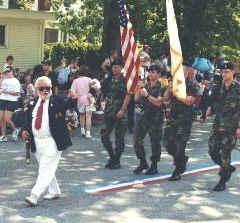Gaspee
Days Committee History
Files History
Files |
| The
Rhode Island
Mace
The Rhode Island Mace has been carried at the head of the Gaspee Days Parade every year since the first observance of Gaspee Days in June, 1966. Former Warwick City Councilman Gerald S. Goldstein has carried it every year until the early 1990's, after which the honor was given to "Mr. Gaspee', Milton Wrath. In 2007 Milton Wrath passed that honor on to Past President of the Gaspee Days, Mark Russell When Briadier General Hunter C.
White, Sr.
was High Sheriff of Providence County over a century ago, he
commissioned the creation of the staff . The Mace has been used in the Inaugural ceremonies for Rhode Island Governors by the High Sheriff of Providence County since Governor Charles D. Kimball was sworn in on January 7, 1902. The only exception has been during World War I when its owner at the time, General White, was with the American Expeditionary Forces in Europe, and in 2002 when no one in the staff on Donald Carcieri thought to ask for its use. The Mace, made of historic fragments
of
wood, is closely
associated with the historical backgrounds of the state and the
nation. The eagle on the top of the mace was carried through the
Civil War on top of a staff which wore a Union battle flag. Part of the
wood was once taken from the much hated British revenue schooner H.M.S.
Gaspee which was burned after being caught on a sand bar off
Gaspee
Point on the evening of June 9, 1772. Another portion of the wood came
from colonial Governor Arthur Fenner's homestead in Cranston; which was
built in 1680 and demolished in 1895. As to exactly where General White
obtained
the wood from the Gaspee is anyone's guess. It may have come from one
of the four wooden canes carved by Ephraim
Bowen in 1804. A descendant of the Fenners, Susan
Fenner
Latshaw, wrote us in 2008 with the following information: Captain
Arthur Fenner whose homestead in |
| Back to Gaspee Days Committee History files |
